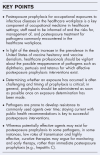Postexposure prophylaxis for occupational exposure to selected pathogens for healthcare personnel
- PMID: 38899948
- PMCID: PMC11213494
- DOI: 10.1097/QCO.0000000000001029
Postexposure prophylaxis for occupational exposure to selected pathogens for healthcare personnel
Abstract
Purpose of review: Timely postexposure prophylaxis is important after an occupational exposure. Here we review select organisms, exposure opportunities in the healthcare setting, and postexposure prophylaxis regimens.
Recent findings: Needlestick injuries pose a risk of exposure to bloodborne pathogens, such as HIV, Hepatitis B, and Hepatitis C. Risk mitigation strategies should be reexamined in light of newer vaccines and therapeutics. Increased vaccine hesitancy and vaccine denialisms may foster the re-emergence of some infections that have become extremely uncommon because of effective vaccines. With increasing occurrences of zoonotic infections and the ease of global spread as evidenced by COVID-19 and mpox, healthcare exposures must also consider risks related to emerging and re-emerging infectious diseases.
Summary: Early recognition and reporting of occupational exposures to pathogens with available postexposure prophylaxis is key to mitigating the risk of transmission. Providers should be able to evaluate the exposure and associated risks to provide prompt and appropriate postexposure prophylaxis.
Copyright © Written work prepared by employees of the Federal Government as part of their official duties is, under the U.S. Copyright Act, a “work of the United States Government” for which copyright protection under Title 17 of the United States Code is not available. As such, copyright does not extend to the contributions of employees of the Federal Government.
Conflict of interest statement
Similar articles
-
[CME: Postexposure Prophylaxis Following Needlestick Injuries and Non-Occupational Exposures].Praxis (Bern 1994). 2019;108(16):1047-1057. doi: 10.1024/1661-8157/a003331. Praxis (Bern 1994). 2019. PMID: 31822230 German.
-
Pilot study of postexposure prophylaxis for hepatitis C virus in healthcare workers.Infect Control Hosp Epidemiol. 2009 Oct;30(10):1000-5. doi: 10.1086/605718. Infect Control Hosp Epidemiol. 2009. PMID: 19743901 Free PMC article. Clinical Trial.
-
Work safety among Polish health care workers in respect of exposure to bloodborne pathogens.Med Pr. 2013;64(1):1-10. Med Pr. 2013. PMID: 23650763
-
[What (general/abdominal) surgeons should know about occupational medicine? : General vaccine recommendations and postexposure prophylaxis of hepatitis B, C and HIV].Chirurg. 2022 Feb;93(2):158-164. doi: 10.1007/s00104-021-01502-w. Epub 2021 Sep 15. Chirurg. 2022. PMID: 34524487 Free PMC article. Review. German.
-
Occupational Health Update: Focus on Preventing the Acquisition of Infections with Pre-exposure Prophylaxis and Postexposure Prophylaxis.Infect Dis Clin North Am. 2016 Sep;30(3):729-57. doi: 10.1016/j.idc.2016.04.008. Infect Dis Clin North Am. 2016. PMID: 27515145 Free PMC article. Review.
Cited by
-
Urgent focus on enhanced recovery after surgery of AIDS patients with limb fractures.Bone Joint Res. 2024 Nov 12;13(11):647-658. doi: 10.1302/2046-3758.1311.BJR-2024-0247.R1. Bone Joint Res. 2024. PMID: 39530173 Free PMC article.
References
-
- Centers for Disease Control and Prevention. Meningococcal Disease: Infection Control in Healthcare Personnel: Epidemiology and Control of Selected Infections Transmitted Among Healthcare Personnel and Patients Atlanta, GA: U.S. Department of Health and Human Services; 2024 [updated November 2, 2022; cited 3/21/2024]. Available at: https://www.cdc.gov/infectioncontrol/guidelines/healthcare-personnel/sel....
-
- McNamara L, Blain, A. Manual for the Surveillance of Vaccine-Preventable Diseases: Chapter 8: Meningococcal Disease. Atlanta, GA: Centers for Disease Control and Prevention; 2024 [updated 1/5/2022. Available at: https://www.cdc.gov/vaccines/pubs/surv-manual/chpt08-mening.html.
-
- Berry I, Rubis AB, Howie RL, et al. . Selection of antibiotics as prophylaxis for close contacts of patients with meningococcal disease in areas with ciprofloxacin resistance – United States, 2024. MMWR Morb Mortal Wkly Rep 2024; 73:99–103. - PMC - PubMed
-
An important notice about the presence of increasing ciprofloxacin resistance among meningococci in selected areas of the US.
-
- Food and Drug Administration. Penbraya Washington, DC: U.S. Department of Health and Human Services; 2024 [updated 11/27/2023; cited 4/2/2024]. Available at: https://www.fda.gov/vaccines-blood-biologics/vaccines/penbraya.
-
- Murthy N, Wodi AP, McNally VV, et al. . Advisory committee on immunization practices recommended immunization schedule for adults aged 19 years or older – United States. MMWR Morb Mortal Wkly Rep 2024; 73:11–15. - PMC - PubMed
-
The CDC's Advisory Committee on Immunization Practices’ recommendations for people 19 years of age or older that includes the first recommendation for the use of the pentavalent meningococcal vaccine.
Publication types
MeSH terms
LinkOut - more resources
Full Text Sources
Medical
Research Materials


